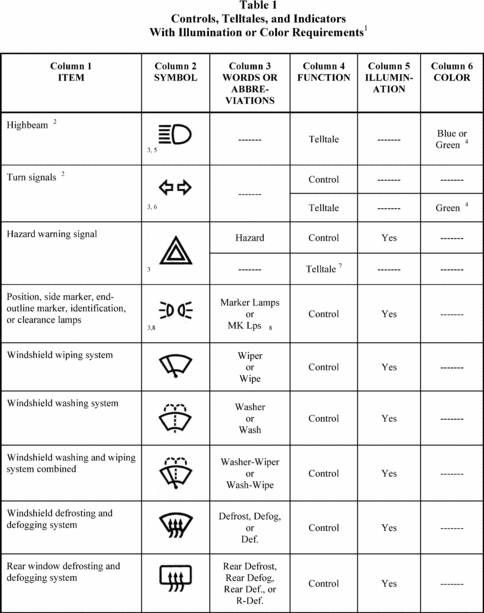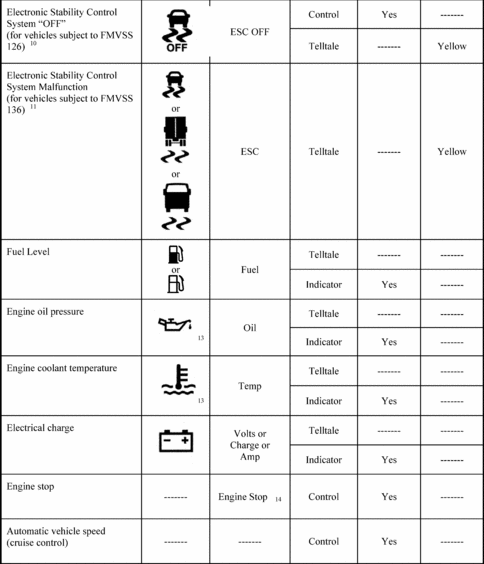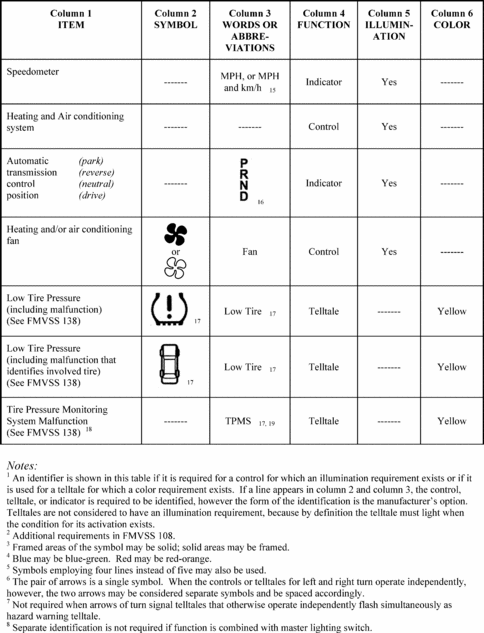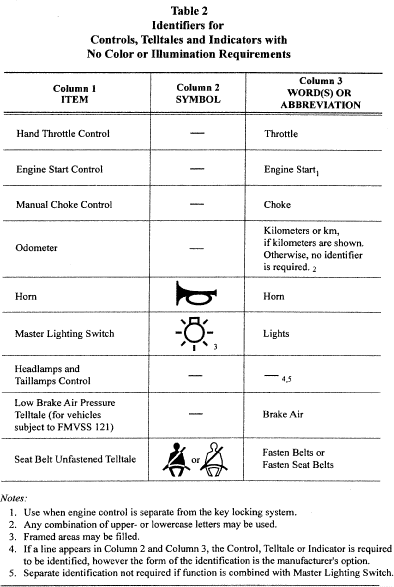Title 49
SECTION 571.101
571.101 Standard No. 101; Controls and displays.
§ 571.101 Standard No. 101; Controls and displays.S1. Scope. This standard specifies performance requirements for location, identification, color, and illumination of motor vehicle controls, telltales and indicators.
S2. Purpose. The purpose of this standard is to ensure the accessibility, visibility and recognition of motor vehicle controls, telltales and indicators, and to facilitate the proper selection of controls under daylight and nighttime conditions, in order to reduce the safety hazards caused by the diversion of the driver's attention from the driving task, and by mistakes in selecting controls.
S3. Application. This standard applies to passenger cars, multipurpose passenger vehicles, trucks, and buses.
S4. Definitions.
Adjacent, with respect to a control, telltale or indicator, and its identifier means:
(a) The identifier is in close proximity to the control, telltale or indicator; and
(b) No other control, telltale, indicator, identifier or source of illumination appears between the identifier and the telltale, indicator, or control that the identifier identifies.
Common space means an area on which more than one telltale, indicator, identifier, or other message may be displayed, but not simultaneously.
Control means the hand-operated part of a device that enables the driver to change the state or functioning of the vehicle or a vehicle subsystem.
Indicator means a device that shows the magnitude of the physical characteristics that the instrument is designed to sense.
Identifier means a symbol, word, or words used to identify a control, telltale, or indicator.
Multi-function control means a control through which the driver may select, and affect the operation of, more than one vehicle function.
Multi-task display means a display on which more than one message can be shown simultaneously.
Telltale means an optical signal that, when illuminated, indicates the actuation of a device, a correct or improper functioning or condition, or a failure to function.
S5. Requirements. Each passenger car, multipurpose passenger vehicle, truck and bus that is fitted with a control, a telltale or an indicator listed in Table 1 or Table 2 must meet the requirements of this standard for the location, identification, color, and illumination of that control, telltale or indicator. However, the requirements for telltales and indicators do not apply to vehicles with GVWRs of 4,536 kg or greater if these specified vehicles are manufactured before September 1, 2013.
S5.1 LocationS5.1.1 The controls listed in Table 1 and in Table 2 must be located so they are operable by the driver under the conditions of S5.6.2.
S5.1.2 The telltales and indicators listed in Table 1 and Table 2 and their identification must be located so that, when activated, they are visible to a driver under the conditions of S5.6.1 and S5.6.2.
S5.1.3 Except as provided in S5.1.4, the identification for controls, telltales and indicators must be placed on or adjacent to the telltale, indicator or control that it identifies.
S5.1.4 The requirement of S5.1.3 does not apply to a multi-function control, provided the multi-function control is associated with a multi-task display that:
(a) Is visible to the driver under the conditions of S5.6.1 and S5.6.2,
(b) Identifies the multi-function control with which it is associated graphically or using words,
(c) For multi-task displays with layers, identifies on the top-most layer each system for which control is possible from the associated multi-function control, including systems not otherwise regulated by this standard. Subfunctions of the available systems need not be shown on the top-most layer of the multi-task display, and
(d) Identifies the controls of Table 1 and Table 2 with the identification specified in those tables or otherwise required by this standard, whenever those are the active functions of the multi-function control. For lower levels of multi-task displays with layers, identification is permitted but not required for systems not otherwise regulated by this standard.
(e) Does not display telltales listed in Table 1 or Table 2.
S5.2 IdentificationS5.2.1 Except for the Low Tire Pressure Telltale, each control, telltale and indicator that is listed in column 1 of Table 1 or Table 2 must be identified by the symbol specified for it in column 2 or the word or abbreviation specified for it in column 3 of Table 1 or Table 2. If a symbol is used, each symbol provided pursuant to this paragraph must be substantially similar in form to the symbol as it appears in Table 1 or Table 2. If a symbol is used, each symbol provided pursuant to this paragraph must have the proportional dimensional characteristics of the symbol as it appears in Table 1 or Table 2. The Low Tire Pressure Telltale (either the display identifying which tire has low pressure or the display which does not identify which tire has low pressure) shall be identified by the appropriate symbol designated in column 4, or both the symbol in column 4 and the words in column 3. No identification is required for any horn (i.e., audible warning signal) that is activated by a lanyard or by the driver pressing on the center of the face plane of the steering wheel hub; or for a turn signal control that is operated in a plane essentially parallel to the face plane of the steering wheel in its normal driving position and which is located on the left side of the steering column so that it is the control on that side of the column nearest to the steering wheel face plane. However, if identification is provided for a horn control in the center of the face plane of the steering wheel hub, the identifier must meet Table 2 requirements for the horn.
S5.2.2 Any symbol, word, or abbreviation not shown in Table 1 or Table 2 may be used to identify a control, a telltale or an indicator that is not listed in those tables.
S5.2.3 Supplementary symbols, words, or abbreviations may be used at the manufacturer's discretion in conjunction with any symbol, word, or abbreviation specified in Table 1 or Table 2.
S5.2.4 [Reserved]S5.2.5 A single symbol, word, or abbreviation may be used to identify any combination of the control, indicator, and telltale for the same function.
S5.2.6 Except as provided in S5.2.7, all identifications of telltales, indicators and controls listed in Table 1 or Table 2 must appear to the driver to be perceptually upright. A rotating control that has an “off” position shall appear to the driver perceptually upright when the rotating control is in the “off” position.
S5.2.7 The identification of the following items need not appear to the driver to be perceptually upright:
(a) A horn control;
(b) Any control, telltale or indicator located on the steering wheel, when the steering wheel is positioned for the motor vehicle to travel in a direction other than straight forward; and
(c) Any rotating control that does not have an “off” position.
S5.2.8 Each control for an automatic vehicle speed system (cruise control) and each control for heating and air conditioning systems must have identification provided for each function of each such system.
S5.2.9 Each control that regulates a system function over a continuous range must have identification provided for the limits of the adjustment range of that function. If color coding is used to identify the limits of the adjustment range of a temperature function, the hot limit must be identified by the color red and the cold limit by the color blue. If the status or limit of a function is shown by a display not adjacent to the control for that function, both the control (unless it is a multi-function control complying with S5.1.4) and the display must be independently identified as to the function of the control, in compliance with S5.2.1, on or adjacent to the control and on or adjacent to the display.
Example 1.A slide lever controls the temperature of the air in the vehicle heating system over a continuous range, from no heat to maximum heat. Since the control regulates a single function over a quantitative range, only the extreme positions require identification. Example 2.A switch has three positions, for heat, defrost, and air conditioning. Since each position regulates a different function, each position must be identified. S5.3 Illumination S5.3.1 Timing of illumination(a) Except as provided in S5.3.1(c), the identifications of controls for which the word “Yes” is specified in column 5 of Table 1 must be capable of being illuminated whenever the headlamps are activated. This requirement does not apply to a control located on the floor, floor console, steering wheel, steering column, or in the area of windshield header, or to a control for a heating and air-conditioning system that does not direct air upon the windshield.
(b) Except as provided in S5.3.1(c), the indicators and their identifications for which the word “Yes” is specified in column 5 of Table 1 must be illuminated whenever the vehicle's propulsion system and headlamps are activated.
(c) The indicators, their identifications and the identifications of controls need not be illuminated when the headlamps are being flashed or operated as daytime running lamps.
(d) At the manufacturer's option, any control, indicator, or their identifications may be capable of being illuminated at any time.
(e) A telltale must not emit light except when identifying the malfunction or vehicle condition it is designed to indicate, or during a bulb check.
S5.3.2 Brightness of illumination of controls and indicatorsS5.3.2.1 Means must be provided for illuminating the indicators, identifications of indicators and identifications of controls listed in Table 1 to make them visible to the driver under daylight and nighttime driving conditions.
S5.3.2.2 The means of providing the visibility required by S5.3.2.1:
(a) Must be adjustable to provide at least two levels of brightness;
(b) At a level of brightness other than the highest level, the identification of controls and indicators must be barely discernible to the driver who has adapted to dark ambient roadway condition;
(c) May be operable manually or automatically; and
(d) May have levels of brightness, other than the two required visible levels of brightness, at which those items and identification are not visible.
(1) If the level of brightness is adjusted by automatic means to a point where those items or their identification are not visible to the driver, means shall be provided to enable the driver to restore visibility.
S5.3.3 Brightness of telltale illumination(a) Means must be provided for illuminating telltales and their identification sufficiently to make them visible to the driver under daylight and nighttime driving conditions.
(b) The means for providing the required visibility may be adjustable manually or automatically, except that the telltales and identification for brakes, highbeams, turn signals, and safety belts may not be adjustable under any driving condition to a level that is invisible.
S5.3.4 Brightness of interior lamps. (a) Any source of illumination within the passenger compartment which is forward of a transverse vertical plane 110 mm rearward of the manikin “H” point with the driver's seat in its rearmost driving position, which is not used for the controls and displays regulated by this standard, which is not a telltale, and which is capable of being illuminated while the vehicle is in motion, shall have either:(1) Light intensity which is manually or automatically adjustable to provide at least two levels of brightness;
(2) A single intensity that is barely discernible to a driver who has adapted to dark ambient roadway conditions;or
(3) A means of being turned off.
(b) Paragraph (a) of S5.3.4 does not apply to buses that are normally operated with the passenger compartment illuminated.
S5.3.5 The provisions of S5.3.4 do not apply to buses that are normally operated with the passenger compartment illuminated.
S5.4 ColorS5.4.1 The light of each telltale listed in Table 1 must be of the color specified for that telltale in column 6 of that table.
S5.4.2 Any indicator or telltale not listed in Table 1 and any identification of that indicator or telltale must not be a color that masks the driver's ability to recognize any telltale, control, or indicator listed in Table 1.
S5.4.3 Each identifier used for the identification of a telltale, control or indicator must be in a color that stands out clearly against the background. However, this requirement does not apply to an identifier for a horn control in the center of the face plane of the steering wheel hub. For vehicles with a GVWR of under 4,536 kg (10,000 pounds), the compliance date for this provision is September 1, 2011. For vehicles with a GVWR of 4,536 kg (10,000 pounds) or over, the compliance date for this provision is September 1, 2013.
S5.5 Common space for displaying multiple messagesS5.5.1 A common space may be used to show messages from any sources, subject to the requirements in S5.5.2 through S5.5.6.
S5.5.2 The telltales for any brake system malfunction required by Table 1 to be red, air bag malfunction, low tire pressure, electronic stability control malfunction (as of September 1, 2011), passenger air bag off, high beam, turn signal, and seat belt must not be shown in the same common space.
S5.5.3 The telltales and indicators that are listed in Table 1 and are shown in the common space must illuminate at the initiation of any underlying condition.
S5.5.4 Except as provided in S5.5.5, when the underlying conditions exist for actuation of two or more telltales, the messages must be either:
(a) Repeated automatically in sequence, or
(b) Indicated by visible means and capable of being selected for viewing by the driver under the conditions of S5.6.2.
S5.5.5 In the case of the telltale for a brake system malfunction, air bag malfunction, side air bag malfunction, low tire pressure, electronic stability control malfunction (as of September 1, 2011), passenger air bag off, high beam, turn signal, or seat belt that is designed to display in a common space, that telltale must displace any other symbol or message in that common space while the underlying condition for the telltale's activation exists.
S5.5.6(a) Except as provided in S5.5.6(b), messages displayed in a common space may be cancelable automatically or by the driver.
(b) Telltales for high beams, turn signal, low tire pressure, and passenger air bag off, and telltales for which the color red is required in Table 1 must not be cancelable while the underlying condition for their activation exists.
S5.6 ConditionsS5.6.1 The driver has adapted to the ambient light roadway conditions.
S5.6.2 The driver is restrained by the seat belts installed in accordance with 49 CFR 571.208 and adjusted in accordance with the vehicle manufacturer's instructions.





 [70 FR 48305, Aug.
17, 2005, as amended at 71 FR 27971, May 15, 2006; 72 FR 17305,
Apr. 6, 2007; 73 FR 54537, Sept. 22, 2008; 74 FR 40764, Aug. 13,
2009; 80 FR 36100, June 23, 2015; 80 FR 54734, Sept. 11, 2015]
[70 FR 48305, Aug.
17, 2005, as amended at 71 FR 27971, May 15, 2006; 72 FR 17305,
Apr. 6, 2007; 73 FR 54537, Sept. 22, 2008; 74 FR 40764, Aug. 13,
2009; 80 FR 36100, June 23, 2015; 80 FR 54734, Sept. 11, 2015]